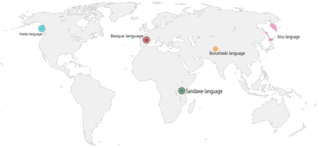Related Research Articles

A language isolate is a language that has no demonstrable genetic relationship with any other languages. Basque in Europe, Ainu in Asia, Sandawe in Africa, Haida and Zuni in North America, Kanoê in South America, Tiwi in Australia and Burushaski in Pakistan are all examples of such languages. The exact number of language isolates is yet unknown due to insufficient data on several languages.

SIL Global is an evangelical Christian nonprofit organization whose main purpose is to study, develop and document languages, especially those that are lesser-known, in order to expand linguistic knowledge, promote literacy, translate the Christian Bible into local languages, and aid minority language development.
The Torricelli Mountains are a mountain range in Sandaun Province, north-western Papua New Guinea. The highest peak in the range is Mount Sulen at 1650 meters. The Bewani Mountains are located to the west, and the Prince Alexander Mountains are located to the east. To the north, the mountains slope down to the Pacific Ocean, and to the south lies the basin of the Sepik River. The mountains are named after the Italian physicist and mathematician Evangelista Torricelli during the German colonial period.

Abom is a nearly extinct language spoken in the Western Province of Papua New Guinea. According to a 2002 census, only 15 people still speak this language. All of the speakers are older adults. Middle-aged adults have some understanding of it, but no children speak or understand Abom.
Watiwa is a Rai Coast language of Papua New Guinea.
The Etoro, or Edolo, are a tribe and ethnic group of Papua New Guinea. Their territory comprises the southern slopes of Mt. Sisa, along the southern edge of the central mountain range of New Guinea, near the Papuan Plateau. They are well known among anthropologists because of ritual acts practiced between the young boys and men of the tribe. The Etoro believe that young males must ingest the semen of their elders to achieve adult male status and to properly mature and grow strong.

Morori is a moribund Papuan language of the Kolopom branch of the Trans–New Guinea family. It is separated from the other Kolopom languages by the intrusive Marind family. All speakers use Papuan Malay or Indonesian as L2, and many know Marind.
Waskia is a Papuan language of Papua New Guinea. It is spoken on half of Karkar Island, and a small part of the shore on the mainland, by 20,000 people; language use is vigorous. The Waskia share their island with speakers of Takia, an Oceanic language which has been restructured under the influence of Waskia, which is the inter-community language. Waskia has been documented extensively by Malcolm Ross and is being further researched by Andrew Pick.
Iyasa is a Bantu language spoken in Cameroon and Equatorial Guinea by the Iyasa and Ndowe coastal fishing peoples. It is also spoken by Pygmies, perhaps Babongo, in Gabon. Approximately 3,000 people speak Iyasa, though some note that this number may be an overestimation.
Mawes was a Papuan language of Indonesia.
The Arafundi languages are a small family of clearly related languages in East Sepik Province, Papua New Guinea. They are conjectured to be related to the Piawi and Madang languages. They are named after the Arafundi River.
Nalu is an Atlantic language of Guinea and Guinea-Bissau, spoken by the Nalu people, a West African people who settled the region before the arrival of the Mandinka in the 14th or 15th centuries. It is spoken predominantly by adults. It is estimated to be spoken by a range of 10,000 to 25,000 people, whereas Wilson (2007) reports that there are around 12,000 speakers. It is considered an endangered language due to its dwindling population of speakers.
Faiwol is one of the Ok languages of Papua New Guinea. It is spoken at the headwaters of the Fly, Palmer, and Murray rivers in Western Province. There are numerous dialects, including Faiwol proper, Angkiyak, Wopkei, Setaman, Selbang, Dimtikin, and Kauwol on the Indonesian border.
Ambunti Rural LLG is a local-level government (LLG) of East Sepik Province, Papua New Guinea. Various Sepik languages are spoken in the LLG.
Sumgilbar Rural LLG is a local-level government (LLG) of Madang Province, Papua New Guinea.
Yamben (Yaben) is a Trans–New Guinea language of Madang Province, Papua New Guinea. It was first documented by Andrew Pick in the 2010s and classified by Pick (2019) as a probable primary branch of Madang, though its precise classification is still pending further research. Although surrounded by Croisilles languages, Yamben is not one of them.
Sinasian Sign Language (SSSL) is a village sign language of the Sinasina valley in Chimbu Province, Papua New Guinea. This language is used by approximately 3 deaf and 50 hearing individuals, including members of the Kere community. SSSL was first encountered and reported by linguist Samantha Rarrick in 2016. Documentation efforts are ongoing.
Bialla Rural LLG is a local-level government (LLG) of West New Britain Province, Papua New Guinea. The Lower dialect of the Ata language is spoken in the LLG.
West Pomio/Mamusi Rural LLG is a local-level government (LLG) of East New Britain Province, Papua New Guinea. The Upper dialect of the Ata language is spoken in the LLG.
References
- 1 2 "Traditional Ecological Knowledge of the Awiakay, Papua New Guinea | Endangered Languages Archive". www.elararchive.org. Retrieved 2024-05-14.
- ↑ "Awiakay". Endangered Languages Project. Retrieved 2024-05-14.